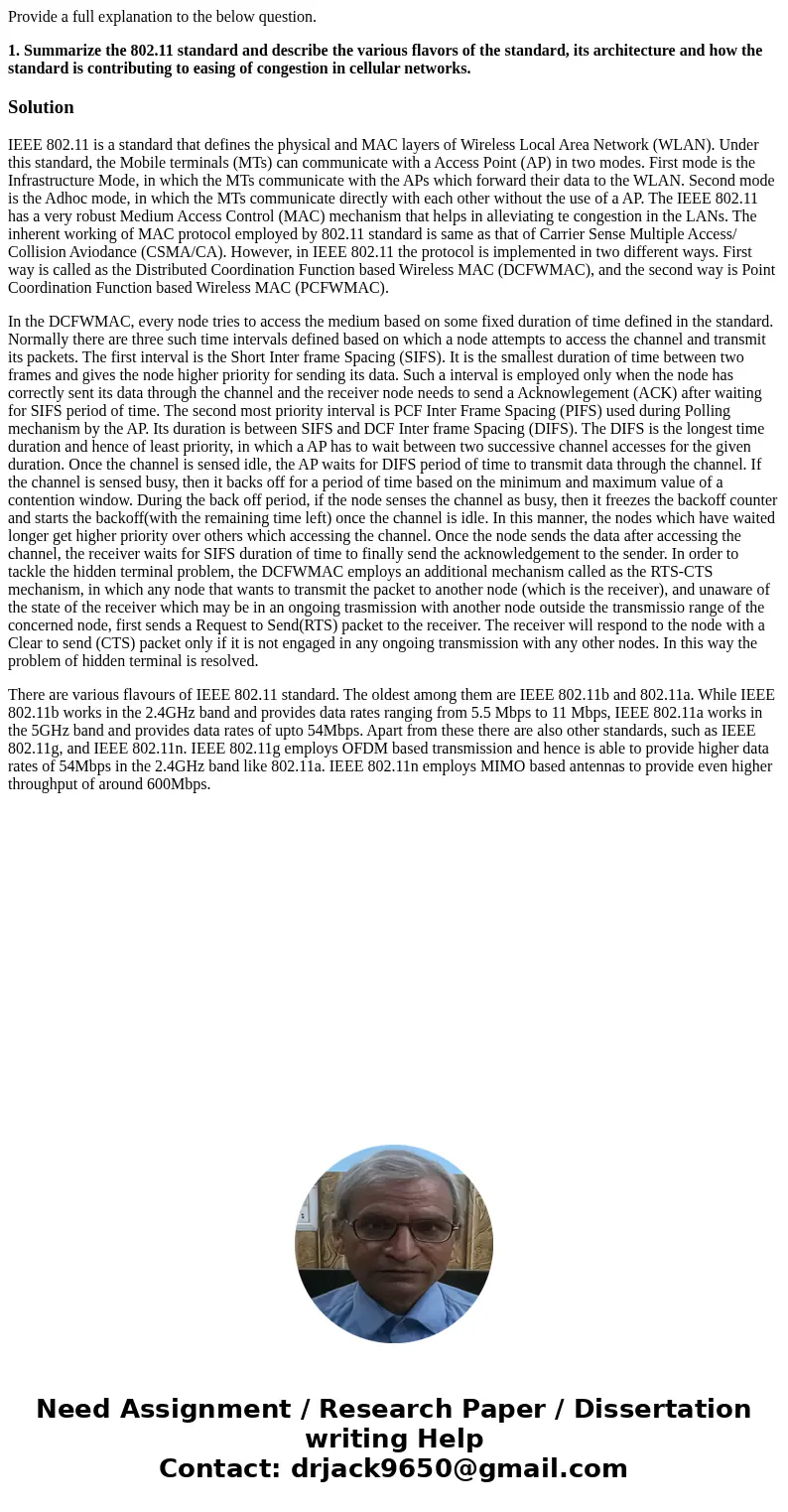Provide a full explanation to the below question 1 Summarize
Provide a full explanation to the below question.
1. Summarize the 802.11 standard and describe the various flavors of the standard, its architecture and how the standard is contributing to easing of congestion in cellular networks.
Solution
IEEE 802.11 is a standard that defines the physical and MAC layers of Wireless Local Area Network (WLAN). Under this standard, the Mobile terminals (MTs) can communicate with a Access Point (AP) in two modes. First mode is the Infrastructure Mode, in which the MTs communicate with the APs which forward their data to the WLAN. Second mode is the Adhoc mode, in which the MTs communicate directly with each other without the use of a AP. The IEEE 802.11 has a very robust Medium Access Control (MAC) mechanism that helps in alleviating te congestion in the LANs. The inherent working of MAC protocol employed by 802.11 standard is same as that of Carrier Sense Multiple Access/ Collision Aviodance (CSMA/CA). However, in IEEE 802.11 the protocol is implemented in two different ways. First way is called as the Distributed Coordination Function based Wireless MAC (DCFWMAC), and the second way is Point Coordination Function based Wireless MAC (PCFWMAC).
In the DCFWMAC, every node tries to access the medium based on some fixed duration of time defined in the standard. Normally there are three such time intervals defined based on which a node attempts to access the channel and transmit its packets. The first interval is the Short Inter frame Spacing (SIFS). It is the smallest duration of time between two frames and gives the node higher priority for sending its data. Such a interval is employed only when the node has correctly sent its data through the channel and the receiver node needs to send a Acknowlegement (ACK) after waiting for SIFS period of time. The second most priority interval is PCF Inter Frame Spacing (PIFS) used during Polling mechanism by the AP. Its duration is between SIFS and DCF Inter frame Spacing (DIFS). The DIFS is the longest time duration and hence of least priority, in which a AP has to wait between two successive channel accesses for the given duration. Once the channel is sensed idle, the AP waits for DIFS period of time to transmit data through the channel. If the channel is sensed busy, then it backs off for a period of time based on the minimum and maximum value of a contention window. During the back off period, if the node senses the channel as busy, then it freezes the backoff counter and starts the backoff(with the remaining time left) once the channel is idle. In this manner, the nodes which have waited longer get higher priority over others which accessing the channel. Once the node sends the data after accessing the channel, the receiver waits for SIFS duration of time to finally send the acknowledgement to the sender. In order to tackle the hidden terminal problem, the DCFWMAC employs an additional mechanism called as the RTS-CTS mechanism, in which any node that wants to transmit the packet to another node (which is the receiver), and unaware of the state of the receiver which may be in an ongoing trasmission with another node outside the transmissio range of the concerned node, first sends a Request to Send(RTS) packet to the receiver. The receiver will respond to the node with a Clear to send (CTS) packet only if it is not engaged in any ongoing transmission with any other nodes. In this way the problem of hidden terminal is resolved.
There are various flavours of IEEE 802.11 standard. The oldest among them are IEEE 802.11b and 802.11a. While IEEE 802.11b works in the 2.4GHz band and provides data rates ranging from 5.5 Mbps to 11 Mbps, IEEE 802.11a works in the 5GHz band and provides data rates of upto 54Mbps. Apart from these there are also other standards, such as IEEE 802.11g, and IEEE 802.11n. IEEE 802.11g employs OFDM based transmission and hence is able to provide higher data rates of 54Mbps in the 2.4GHz band like 802.11a. IEEE 802.11n employs MIMO based antennas to provide even higher throughput of around 600Mbps.

 Homework Sourse
Homework Sourse